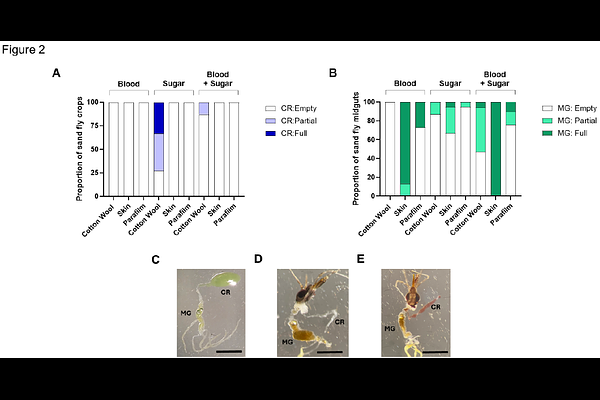Exploiting nectar and blood feeding cues and phagostimulants to optimise Attractive Targeted Sugar Baits against a sand fly vector of leishmaniasis.

Exploiting nectar and blood feeding cues and phagostimulants to optimise Attractive Targeted Sugar Baits against a sand fly vector of leishmaniasis.
Castro, D. P.; Genta, F. A.; Rogers, M. E.
AbstractAbstract Background Leishmaniasis presents a major public health problem for a large number of countries requiring effective integrated management of the vector, sand flies, for sustained control. Such strategies need to be economically and environmentally sustainable and adaptable to the behaviour of local vectors. One such tool is Attractive Targeted Sugar Baits (ATSB) that exploit the necessity of sand flies to acquire sugars between bloodmeals. Here we explored the kinetics and cues for sugar and blood feeding to improve the efficacy of ATSBs against sand flies. Methods A fluorescent assay was developed to quantify sugarmeals to assess the feeding efficiency of colony-reared female Lutzomyia longipalpis sand flies. Results Sand flies showed a range of preferences for different sugars presented on cotton wool and could be manipulated to deposit them into the crop and/or midgut. We found that the combination of 10% sucrose and 10% fructose allowed flies to obtain the largest sugarmeals taken to the crop. Sugarmeals were taken to both the crop and midgut when it contained 200 mM bovine serum albumin (BSA) as a source of protein and 1 mM adenosine triphosphate (ATP) as a phagostimulant. Using this combination, the efficacy of the ingested insecticide fipronil was significantly increased; reducing the 50% lethal concentration from 584 M to 1.65 M in a sugarmeal that promoted the simultaneous uptake of the insecticide into the midgut as well as the crop. Conclusions In this study we highlight the potential of understanding the cues used by vectors to sugar feed and blood feed. By incorporating blood feeding phagostimulants, such as BSA and ATP, in ATSB we vastly improve their killing efficiency against sand flies. This demonstrates a new approach to target these disease vectors.